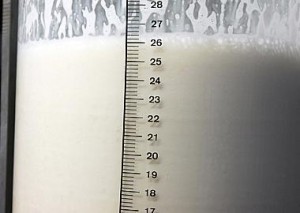EuroTier:  Milk production in Russia is suffering from a lack of investment in processing plants and the continued use of old technology.
Milk production in Russia is suffering from a lack of investment in processing plants and the continued use of old technology.
EuroTier in Hanover
Speaking at the recent EuroTier exhibition in Hanover, Roman Vakuchuk, an economist from the Norwegian Institute of International Affairs said that milk production has remained fairly stable in Russia showing a slight fall in recent years but overall demand has been positive. “The outlook for the sector will be positive for years to come,” he said. Two years ago milk production in Russia reached 31.831 million tonnes. Last year it fell by just over four per cent to 30.529 million tonnes and for the first nine months of this year production was 24.099 million tonnes, with the Volga region of Russia the central point for dairy production and the Moscow region leading consumption. However, Mr Vakuchuk said that while consumption of milk and dairy products in Russia is stable, it is below the global average. He said that recent sanctions have had an effect on the development of the industry in Russia but the sector is in need of support and investment. “State support on the milk industry in Russia is not as big as in other countries,” he said.
Vladimir Labinov
Vladimir Labinov, Head of the Department of Animal Husbandry and Breeding, Ministry of Agriculture of the Russian Federation said that over the past five years, milk production in the agricultural organisations in Russia has fallen by 119.7 million tonnes or 1.4 per cent compared to 2008. In private households it has fallen by 2.1 million tonnes, or 12.3 per cent, in peasant farm holdings (private entrepreneurs), it increased by 424.8 million tonnes or 30.8 per cent. “It is estimated that milk production in 2016 will be increased by 903.6 million tonnes or 6.4 per cent compared to 2013 in agricultural organisations,” he said. “It will increase by 161.5 million tonnes or nine per cent in peasant farm holdings (private entrepreneurs) and will fall by 855.6 million tonnes or 5.8 per cent in private households.” He added: “It is estimated that milk production will be 30.740 million tonnes in 2016, which is 210,000 of tonnes or 0.7 per cent above the level in 2013.
Russia dairy sector
The character of the Russia dairy sector has been gradually changing with more production shifting to the large agricultural organisations and cooperatives. The sector has also seen an improvement in the productivity of the cattle with an increase of 627kg per cow, 16.1 per cent, over the last five years from 3,892kg in 2008 to 4,519kg last year. Mr Labinov said that the amount of subsidies and support that the dairy sector in Russia can expect to receive will also rise. From the total range of subsidies in 2008 of 7.9 billion rubles the range of livestock support and production subsidies is expected to offer producers more than 37 billion rubles in 2017. Mr Labinov added that new kinds of subsidies are also expected to be offered to the farmer for capital outlay to build the farms, to build and develop breeding centres and to develop breeding stock identification programmes. He added that the focus of the development of the breeding herds and the farms was to include breeds producing not only larger yields, but also improved quality milk with improved fat and protein content.
Thanks to http://www.thecattlesite.com for this interview at EuroTier.

